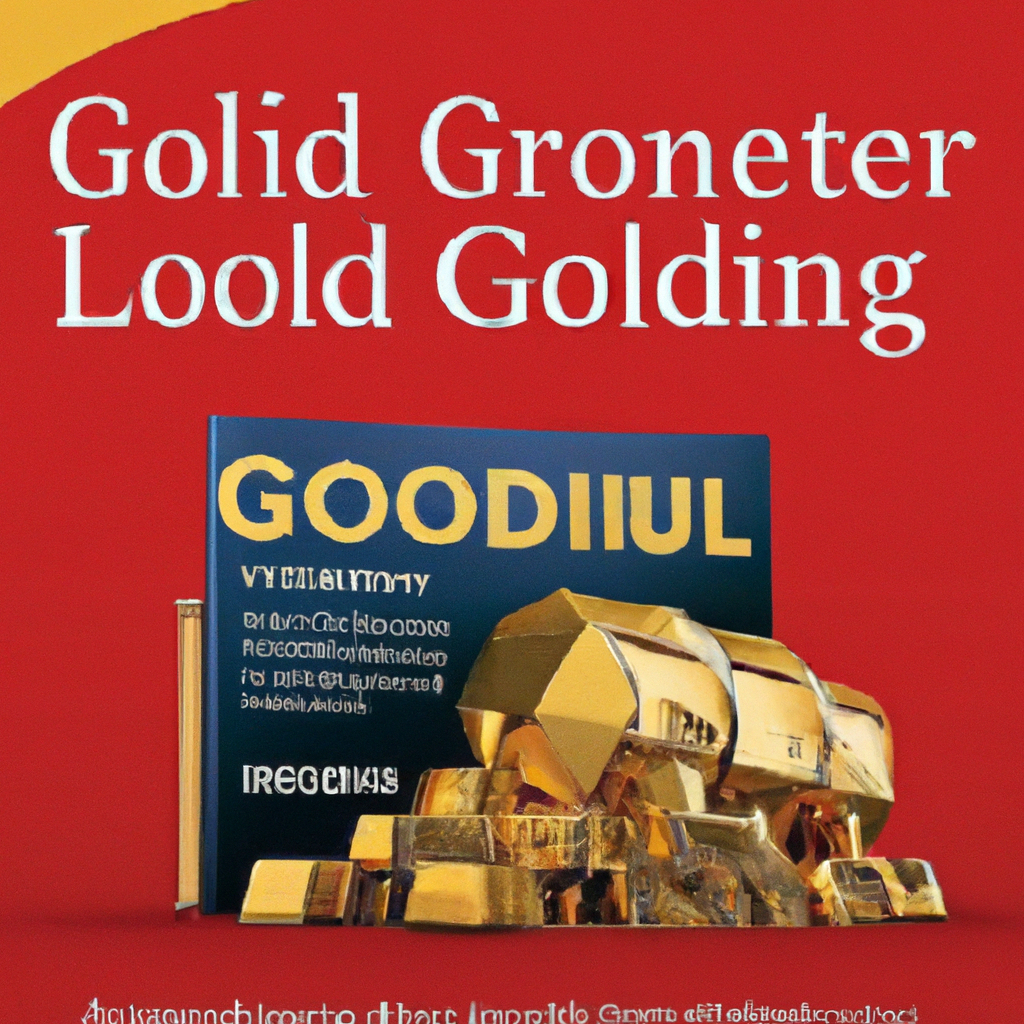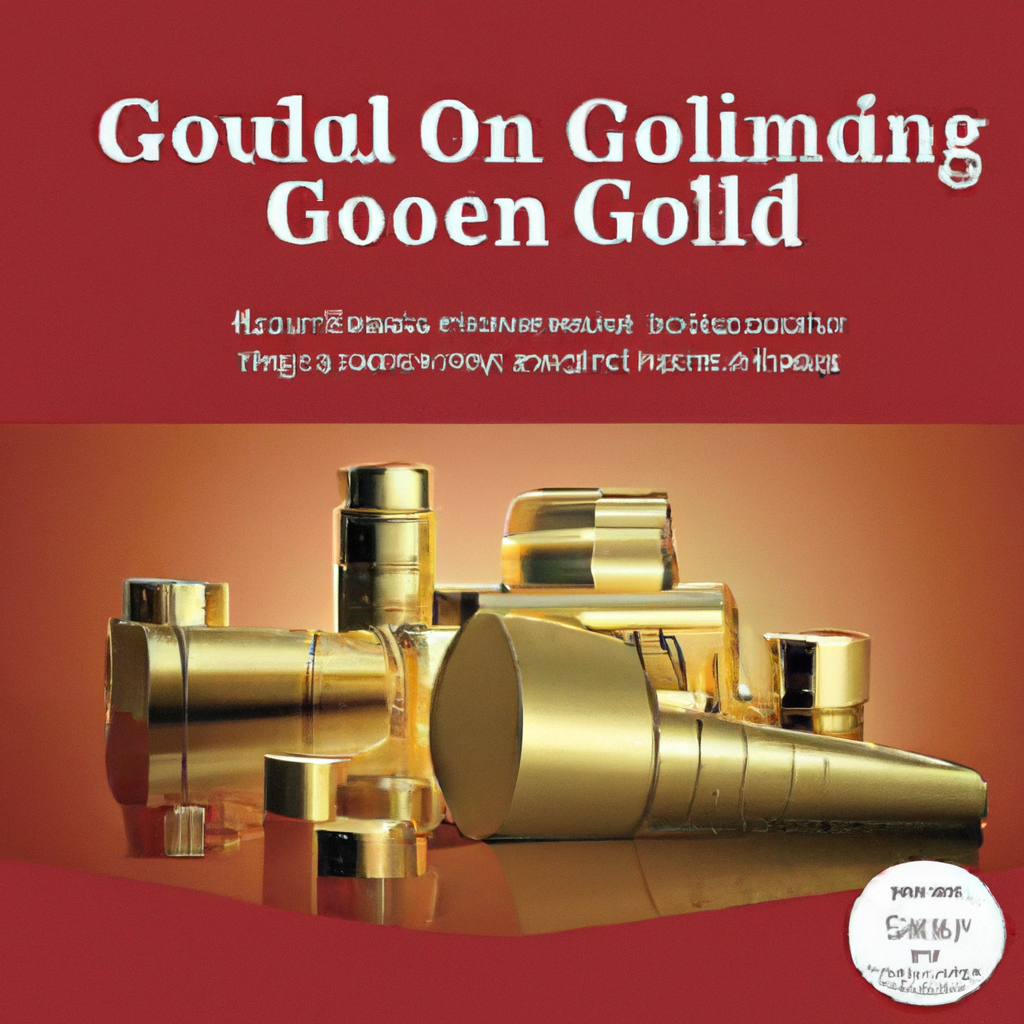Interested in investing in commodities like gold or oil? Wondering how to get started? Look no further! In this article, we will guide you through the process of investing in these valuable commodities, helping you navigate the world of commodities investments with ease. Whether you’re a seasoned investor or a beginner looking to diversify your portfolio, we’ve got you covered. So sit back, relax, and let us show you the ins and outs of investing in commodities like gold or oil.
Understanding Commodities
Commodities are raw materials or primary agricultural products used in the production of goods and services. They are the building blocks of the global economy and can be categorized into different types based on their characteristics and usage. Understanding commodities is essential for investors looking to diversify their portfolios and explore alternative investment options.
What are commodities?
Commodities are goods or products that are interchangeable with other goods of the same type. They are typically produced in large quantities and have uniform quality and specifications. Examples of commodities include gold, oil, natural gas, corn, wheat, and coffee.
Commodities can be broadly classified into two categories: hard commodities and soft commodities. Hard commodities refer to natural resources such as metals (gold, silver, copper), energy resources (oil, natural gas), and agricultural products that can be mined or extracted. Soft commodities, on the other hand, include agricultural products like corn, wheat, soybeans, coffee, and cotton.
Key characteristics of commodities
Commodities possess certain key characteristics that make them unique investment assets. These characteristics include:
-
Universally Valued: Commodities have value across different markets and are widely accepted as mediums of exchange.
-
Limited Supply: Commodities are finite resources, and their availability is influenced by factors such as production rates, technological advancements, and geopolitical events.
-
Inelastic Demand: The demand for commodities tends to be consistent and unaffected by changes in price. Basic human needs, industrial uses, and global economic growth are some factors driving demand.
-
Price Volatility: Commodities exhibit significant price fluctuations due to various factors such as supply and demand dynamics, geopolitical tensions, and weather conditions.
Different types of commodities
Commodities can be classified into several categories based on their characteristics and usage. Some of the major types of commodities include:
-
Energy Commodities: This category includes oil, natural gas, and coal, which are essential for various industries and play a significant role in global energy consumption.
-
Precious Metals: Gold, silver, platinum, and palladium fall under this category. Precious metals are valued for their rarity and are used in jewelry, electronics, and as a hedge against inflation.
-
Industrial Metals: Metals such as copper, aluminum, zinc, and nickel are considered industrial metals. They are vital for manufacturing industries and infrastructure development.
-
Agricultural Commodities: This category includes crops, livestock, and their byproducts. Wheat, corn, soybeans, coffee, sugar, and cattle are examples of agricultural commodities.
-
Soft Commodities: Soft commodities primarily consist of agricultural products, including crops and livestock. This category includes cotton, cocoa, coffee, and sugar.
Investing in Commodities like Gold or Oil
Investing in commodities has gained popularity among investors as a means to diversify portfolios and potentially hedge against inflation or economic uncertainties. Gold and oil are two of the most commonly traded commodities, and understanding the reasons to invest in each can help investors make informed decisions.
Investing in Gold
Why invest in gold
Gold has been regarded as a valuable asset for centuries, and here’s why many investors choose to invest in gold:
-
Safe Haven Asset: Gold is often seen as a safe haven during times of economic uncertainty or market volatility. It has historically retained its value and served as a store of wealth.
-
Hedge Against Inflation: Gold is considered a hedge against inflation as its value tends to rise when the purchasing power of fiat currencies declines.
-
Portfolio Diversification: Including gold in a portfolio can help diversify the risk and reduce the correlation with other assets like stocks and bonds.
-
Limited Supply: Gold is a finite resource, and its scarcity adds to its intrinsic value. The limited supply also means that the price of gold is less susceptible to manipulation.
Methods of investing in gold
There are several methods available for investors to gain exposure to gold:
-
Physical Gold: Investors can purchase physical gold in the form of bars, coins, or jewelry. Owning physical gold provides a tangible asset that can be stored securely.
-
Gold ETFs: Gold Exchange-Traded Funds (ETFs) are securities that track the performance of gold prices. These can be bought and sold like stocks through brokerage accounts.
-
Gold Futures Contracts: Futures contracts are agreements to buy or sell gold at a predetermined price and date in the future. They provide exposure to gold price movements without physically owning the metal.
-
Gold Mining Stocks: Investing in gold mining companies allows investors to gain exposure to the gold market indirectly. Mining stocks can offer potential returns based on the company’s performance and the price of gold.
Factors to consider when investing in gold
Before investing in gold, it is crucial to consider the following factors:
-
Investment Objective: Clarify your investment goals and assess how gold fits into your overall investment strategy. Determine the amount of allocation you are comfortable with based on your risk tolerance and financial objectives.
-
Market Conditions: Analyze the current market conditions, economic outlook, and factors that are likely to impact the price of gold. Factors such as interest rates, inflation rates, and geopolitical events can influence the price of gold.
-
Storage and Safety: If considering physical gold, determine the secure storage options and associated costs. Ensuring the safety of your investment is essential.
-
Costs and Fees: Different investment methods come with varying costs and fees. Consider expenses such as transaction fees, storage charges, and management fees when comparing investment options.
Risks and rewards of investing in gold
Like any investment, investing in gold carries both risks and potential rewards:
-
Price Volatility: Gold prices can be volatile, and short-term fluctuations are common. Investors should be prepared for potential price swings.
-
Economic Factors: Economic factors such as interest rates, inflation, and currency fluctuations can impact the price of gold. Changes in these factors may affect the value of gold investments.
-
Counterparty Risk: Some investment methods, such as gold futures or ETFs, expose investors to counterparty risk. If the counterparty fails to honor their obligations, it may impact the investment’s value.
-
Potential Rewards: Investing in gold can offer potential returns in the form of capital appreciation and can act as a hedge against economic uncertainties.
Understanding the risks and rewards and conducting thorough research can help investors make well-informed decisions when investing in gold.

Investing in Oil
Why invest in oil
Oil is a crucial global energy resource, and investing in oil can present opportunities for investors. Here are some reasons to consider investing in oil:
-
Energy Demand: Oil is the primary source of energy for transportation, heating, and industrial processes. The increasing global energy demand can drive the long-term growth of oil prices.
-
Geopolitical Factors: Geopolitical events and tensions in major oil-producing regions can significantly impact oil prices. Investors may look for opportunities during periods of uncertainty.
-
Inflation Hedge: Oil prices tend to rise with inflation, making oil investments a potential hedge against rising prices.
Methods of investing in oil
Investors can gain exposure to oil prices through various investment methods:
-
Oil Futures Contracts: Futures contracts allow investors to buy or sell oil at a predetermined price and date in the future. They provide a way to speculate or hedge against oil price movements.
-
Oil ETFs: Exchange-Traded Funds (ETFs) tracking oil prices allow investors to participate in the oil market without direct exposure to futures contracts. These funds can be bought and sold like stocks.
-
Oil Company Stocks: Investing in oil company stocks provides exposure to the performance of oil-related companies. Company stock prices can be influenced by factors such as oil prices, production levels, and industry fundamentals.
Factors to consider when investing in oil
Before investing in oil, it is important to consider the following factors:
-
Market Analysis: Analyze the current oil market dynamics, global supply and demand, and geopolitical factors that may impact oil prices. Stay informed about industry trends, production levels, and global events affecting the oil market.
-
Risk Management: Set clear investment goals and determine the level of risk you are willing to accept. Oil investments can be volatile, and having a risk management strategy in place is essential.
-
Long-Term Outlook: Consider the long-term outlook for oil prices. Factors such as technological advancements, renewable energy developments, and government policies can influence the future demand and price of oil.
Risks and rewards of investing in oil
Investing in oil carries its own set of risks and potential rewards:
-
Price Volatility: Oil prices are highly volatile and can be influenced by factors such as geopolitical tensions, global oil supply, and economic conditions. Investors should be prepared for price fluctuations.
-
Industry and Regulatory Risks: The oil industry is subject to regulations, environmental concerns, and geopolitical risks. Changes in government policies or regulations can impact the profitability of oil investments.
-
Diversification Potential: Investing in oil can provide diversification benefits to a portfolio. However, it is important to consider the potential correlation of oil investments with other holdings and the overall risk exposure.
-
Global Economic Factors: Economic conditions and global economic growth can impact oil demand and hence its price. Factors such as GDP growth, interest rates, and currency exchange rates should be monitored.
Understanding the risks and rewards associated with investing in oil is crucial for making informed investment decisions.
Different Investment Vehicles
Investors have various options for investing in commodities, and each investment vehicle offers a unique way to gain exposure to commodity markets.
Physical commodity ownership
Physical commodity ownership involves directly owning and holding the physical commodities themselves. This can include purchasing and storing gold bars or investing in agricultural land for crop production. Owning physical commodities can provide a sense of tangibility and ownership over the asset. However, it also requires storage and security considerations.
Commodity ETFs
Commodity Exchange-Traded Funds (ETFs) are investment funds that trade on stock exchanges and aim to replicate the performance of specific commodity indices. ETFs offer investors an opportunity to gain exposure to various commodities without directly owning the physical assets. Investing in commodity ETFs can provide diversification across different commodities and simplify the investment process.
Commodity futures contracts
Commodity futures contracts allow investors to buy or sell a specific quantity of a commodity at a predetermined price on a specified future date. Futures contracts are traded on commodity exchanges and are commonly used by producers, consumers, and speculators. They provide an opportunity for investors to profit from price fluctuations without owning the physical commodities.
Commodity options
Commodity options give investors the right, but not the obligation, to buy or sell a commodity at a predetermined price within a specified timeframe. Options provide flexibility and can be used for hedging or speculative purposes. Investors pay a premium to purchase options, and the value of options depends on the price of the underlying commodity.
Commodity stocks and funds
Investing in commodity stocks involves buying shares of companies that are engaged in the production, exploration, or distribution of commodities. These companies can include oil and gas companies, mining companies, or agricultural companies. Commodity-focused mutual funds and exchange-traded funds (ETFs) invest in a portfolio of commodity-related stocks and provide exposure to multiple companies within the commodity sector.
Commodity mutual funds
Commodity mutual funds pool money from multiple investors to invest in a diversified portfolio of commodities or commodity-related securities. These funds are managed by professional fund managers who make investment decisions based on market analysis and research. Investing in commodity mutual funds allows investors to access a diversified portfolio without needing to actively manage individual commodities.
Commodity index funds
Commodity index funds mirror the performance of a specific commodity index, such as the S&P GSCI or the Bloomberg Commodity Index. These funds invest in the underlying commodities represented in the index, usually through futures contracts. Commodity index funds provide exposure to a broad range of commodities and can be used for long-term investment strategies.
Each investment vehicle has its own advantages and considerations, and investors should evaluate their investment goals, risk tolerance, and desired level of involvement before choosing a suitable option.

Analyzing Commodities
Analyzing commodities requires assessing various aspects that can influence their prices and market dynamics. Understanding the factors that affect commodity prices can help investors make informed decisions and identify potential investment opportunities.
Supply and demand
Supply and demand factors play a crucial role in determining commodity prices. Changes in production levels, weather conditions, technological advancements, and geopolitical events can impact the supply side of commodities. On the demand side, factors such as economic growth, population growth, and industrial demand can influence the level of demand for commodities. Tracking supply and demand dynamics is essential to gauge potential price movements.
Market fundamentals
Analyzing market fundamentals involves understanding the specific factors that affect a particular commodity. This includes factors such as production costs, storage and transportation costs, regulatory environment, and industry trends. Market fundamentals can provide insights into the competitiveness of a particular commodity and its long-term supply and demand dynamics.
Macroeconomic factors
Macroeconomic factors can have a significant impact on commodity prices. Economic indicators such as GDP growth rates, interest rates, inflation rates, and currency exchange rates can influence commodity demand and pricing. Understanding the broader economic trends and their potential impact on commodities is essential for commodity analysis.
Technical analysis
Technical analysis involves studying historical price patterns, trade volumes, and other market data to predict future price movements. Chart patterns, trend lines, and various technical indicators are used to analyze market sentiment and identify potential trading opportunities. While technical analysis can be a useful tool, it should be used in conjunction with other forms of analysis to make well-informed investment decisions.
Analyzing commodities requires a holistic approach that combines a thorough understanding of supply and demand dynamics, market fundamentals, macroeconomic factors, and technical analysis. By considering all these factors, investors can make more informed decisions when investing in commodities.
Understanding the Risks
Investing in commodities comes with its own set of risks. Understanding these risks is crucial for investors to make informed decisions and manage their investment portfolios effectively.
Price volatility
Commodity prices can be highly volatile, making them susceptible to significant price swings in a short period. Factors such as supply and demand imbalances, geopolitical events, weather conditions, and changes in market sentiment can trigger rapid price movements. Investors must be prepared for price volatility and consider it as part of their risk management strategy.
Geopolitical risks
Geopolitical events and tensions can have a significant impact on commodity prices. Conflicts in major oil-producing regions, trade disputes, political instability, or changes in government policies can disrupt commodity supply chains and influence prices. Investors should stay informed about geopolitical developments and their potential impact on commodity markets.
Market risk
Commodity prices are influenced by various factors beyond investors’ control, such as global economic conditions, technological advancements, and weather patterns. These factors introduce market risk, which is the risk associated with general market conditions and performance. Investors should be aware of market risk and diversify their portfolios to mitigate it.
Liquidity risk
Some commodities may have lower trading volumes compared to more established markets such as stocks or bonds. This can result in lower liquidity, which affects the ease at which investors can buy or sell commodities without significantly impacting prices. Investors must consider the liquidity risk associated with the commodities they choose to invest in.
Currency risk
Commodities are often priced in a specific currency, such as the U.S. dollar. Fluctuations in currency exchange rates can impact commodity prices, especially for investors trading commodities in currencies other than their own. Currency risk should be considered when investing in commodities to understand the potential impact on investment returns.
Understanding the risks associated with investing in commodities is crucial for investors to develop appropriate risk management strategies and make informed investment decisions. By assessing and managing these risks, investors can navigate the commodity market more effectively.

Developing an Investment Strategy
Developing an investment strategy is essential for investors looking to invest in commodities. Having a clear plan in place can help investors achieve their investment goals and manage risk effectively. Here are some key considerations when developing an investment strategy for commodities.
Setting investment goals
Define clear investment goals that align with your overall financial objectives. Determine whether you seek long-term capital appreciation, income generation, or portfolio diversification. Setting realistic and measurable investment goals will guide your investment decisions and help determine the appropriate level of risk to take on.
Asset allocation
Determine the percentage of your investment portfolio allocated to commodities. Asset allocation involves spreading investments across different asset classes to manage risk and potentially enhance returns. Consider your risk tolerance, investment horizon, and other asset classes in your portfolio when deciding on the appropriate allocation to commodities.
Diversification
Diversification is a key principle in investing that involves spreading investments across different assets to reduce risk. Investing in a variety of commodities, as well as other asset classes, can help mitigate the impact of an individual commodity’s performance on your overall investment portfolio. Consider diversifying across different commodity types, geographical regions, and investment vehicles.
Entry and exit points
Identify the preferred entry and exit points for your commodity investments. Timing the market perfectly is challenging, but having a strategy in place can help investors make more informed decisions. Entry points can be based on technical analysis, fundamental analysis, or a combination of both. Likewise, identify predetermined exit points or profit-taking strategies to lock in gains or limit losses.
Risk management
Risk management involves identifying and managing the risks associated with your investments. Consider implementing risk management techniques such as setting stop-loss orders, maintaining a diversified portfolio, and regularly monitoring your investments. Periodically reviewing and adjusting your investment strategy can help ensure it aligns with your risk tolerance and current market conditions.
Developing an investment strategy provides a structured approach to investing in commodities. By setting investment goals, determining asset allocation and diversification, establishing entry and exit points, and implementing risk management measures, investors can navigate the commodity market more effectively.
Researching and Monitoring
Researching and monitoring the commodities market is vital to make informed investment decisions and stay updated on market trends and developments. Here are some key aspects to consider when researching and monitoring commodities.
Accessing market information
Stay informed by utilizing various sources of market information. Financial news websites, commodity exchanges, industry publications, and government reports can provide valuable insights into supply and demand dynamics, pricing trends, and fundamental indicators for specific commodities. Create a list of reliable sources and regularly review and analyze the data they provide.
Evaluating commodity trends
Identify the key trends within the commodity market by analyzing historical price patterns, production levels, consumption rates, and demand forecasts. Charting tools, technical indicators, and trend analysis can help identify potential investment opportunities. Monitoring the trend in commodity prices and factors influencing these trends can support investment decision-making.
Monitoring economic indicators
Pay attention to macroeconomic indicators that can impact commodity prices, such as GDP growth rates, interest rates, inflation levels, and unemployment rates. Economic data releases can provide insights into the overall health of the economy and help predict future demand for commodities. Understanding the relationship between economic indicators and commodity prices is crucial for forecasting commodity market trends.
Staying updated with news and events
Stay updated with news related to specific commodities, such as geopolitical events, weather forecasts, regulatory changes, and industry news. These factors can significantly impact commodity prices. Utilize news websites, industry publications, and financial news networks to stay informed about the latest developments. News and events can provide valuable cues for adjusting investment positions and managing risk.
Researching and monitoring commodities require ongoing effort and vigilance. By accessing market information, evaluating commodity trends, monitoring economic indicators, and staying updated with news and events, investors can make well-informed investment decisions and adjust their strategies when necessary.
Working with a Financial Advisor
Working with a financial advisor can provide valuable guidance and support when investing in commodities. Here are some key considerations when seeking the assistance of a financial advisor:
Benefits of a financial advisor
A financial advisor can offer a range of benefits when investing in commodities:
-
Expertise and Knowledge: Financial advisors have specialized knowledge and experience in the commodity markets. They can provide insights, research, and investment recommendations based on their expertise.
-
Tailored Investment Advice: A financial advisor can assess your investment goals, risk tolerance, and financial circumstances to provide personalized investment strategies that align with your objectives.
-
Portfolio Diversification: By examining your entire investment portfolio, a financial advisor can help you diversify your holdings across different asset classes, including commodities, to manage risk effectively.
Finding a reputable advisor
When seeking a financial advisor, consider the following factors:
-
Credentials and Experience: Look for advisors who have relevant credentials such as Certified Financial Planner (CFP) or Chartered Financial Analyst (CFA) designations. Experience in commodity markets or working with clients with similar investment goals is also valuable.
-
Client Reviews and Referrals: Read client reviews and seek referrals from trusted sources to ensure the advisor has a track record of providing quality service.
-
Transparent Fee Structure: Understand the fee structure and how the advisor is compensated. Fee-only advisors who charge a transparent fee based on the services provided may be preferable to those who receive commissions based on investment product sales.
Communication and collaboration
Establish clear and open communication with your financial advisor. Communicate your investment goals, risk tolerance, and any changes in your financial circumstances. Regularly review and discuss your investment portfolio, performance, and any adjustments that may be necessary.
Regular portfolio reviews
Schedule regular portfolio reviews with your financial advisor to assess the performance of your investments. Discuss any changes in market conditions, rebalancing opportunities, or new investment opportunities. Regular reviews can help ensure your investment strategy remains aligned with your objectives.
Conclusion
Investing in commodities like gold or oil can be a valuable addition to an investment portfolio, providing diversification and potential returns. Understanding the characteristics of commodities, the investment options available, and the various risks and rewards associated with investing in commodities is essential for successful investing. By developing a well-defined investment strategy, conducting thorough research and monitoring, and working with a reputable financial advisor, investors can confidently navigate the complex world of commodities and take the first steps towards realizing their investment goals.




